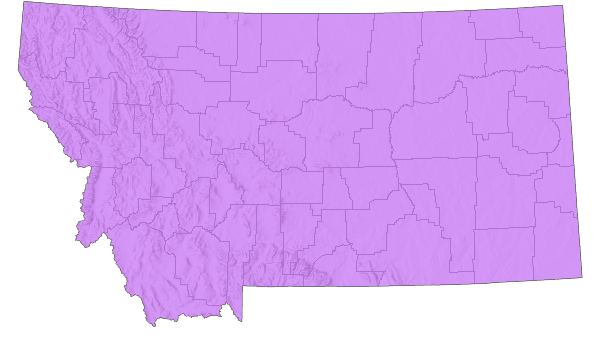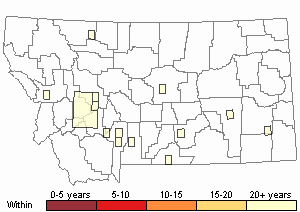View in other NatureServe Network Field Guides
NatureServe
Montana
Utah
Wyoming
Idaho
Wisconsin
British Columbia
South Carolina
Yukon
California
New York
Campestral Grasshopper - Spharagemon campestris
General Description
The following is taken from Hebard (1928), Brooks (1958), Helfer (1971), Capinera and Sechrist (1982), Otte (1984), Vickery and Kevan (1985), Capinera et al. (2004), Brust et al. (2008), and Scott (2010). This species may be found named in both the past and present literature as Trimerotropis campestris. This is a medium size, slender, brown, or gray grasshopper mottled with dark spots. Often the head and pronotum (thorax) are paler in color and without spots. The tegmina (forewings) bear irregular, undefined bands and extends beyond the abdominal tip. The disk of the hind wings is yellow with a wide dark band and long spur nearly reaching the wing base. The carina (ridge) on the dorsal surface of the pronotum is elevated and cut by 2 sulci (grooves). Outer face of the hind femur is faintly spotted or banded; the inner face is orange to red-orange with a black ring and knee. The hind tibia is orange to red.
Communicative behavior/Crepitation*
Both sexes crepitate in flight when disturbed. During display flights, solitary males produce a snapping sound. When courting a female, the males employ three signals: (1) bursts of vibratory stridulation with one femur, (2) femur tipping, and (3) trills of stridulation. In male-to-male aggressive encounters, they shake and tip their hind femurs (Otte 1970, 1984, and Vickery and Kevan 1985).
*Crepitation is the sound produced by grasshoppers making a clicking or snapping noise with their wings when in flight, during courtship, territorial encounters or being disturbed.
Phenology
This species overwinters in the egg stage. Nymphs occur in early June to early July, and adults from mid-July through September (Otte 1970, 1984, and Vickery and Kevan 1985).
Diagnostic Characteristics
The following comes from Hebard (1928), Brooks (1958), Helfer (1971), Capinera and Sechrist (1982), Otte (1984), Vickery and Kevan (1985), Capinera et al. (2004), Brust et al. (2008), and Scott (2010). The body length to end of forewings is 25-30 mm for males, and 28-40 mm in females.
The Campestral Grasshopper can be confused with two Montana
Trimerotropis species:
latifasciata and
pristinaria. It can be separated from these two species by its undefined, faded edged crossbands on the forewings. This species is closely related to its congener,
Say’s Grasshopper (
Spharagemon equale), but separated by possessing a higher pronotal carina (ridge) usually cut by two sulci (grooves) (Otte 1984).
Species Range
Montana Range
Range Descriptions

 Native
Native
Range Comments
The Campestral Grasshopper occurs from southeast British Columbia, across southern Alberta to Manitoba, and southward to New Mexico and north Rio Grande of Mexico, and southwest Texas. West to east from the eastern half of Washington, Oregon, some of Nevada, to the Dakotas and panhandle of Nebraska. In Montana, it has been reported for 23 counties (Otte 1984, Vickery and Kevan 1985, Capinera et al. 2004, and Scott 2010).
Observations in Montana Natural Heritage Program Database
Number of Observations: 21
(Click on the following maps and charts to see full sized version)
Map Help and Descriptions
Relative Density

Recency


 (Observations spanning multiple months or years are excluded from time charts)
(Observations spanning multiple months or years are excluded from time charts)
Habitat
This species inhabits mountain meadows to elevations up to 10,000 feet, grasslands, some prairies, dry hillsides, and gravelly to rocky areas in parklands. Also favors wheatgrass-bluegrass habitats (Otte 1984, Vickery and Kevan 1985, Brust et al. 2008).
Food Habits
The food habits of this species are poorly known, but believed to feed on a mix of grasses, sedges, and some forbs, showing a preference for milkvetch, Astragaus sp. (Brooks 1958, Vickery and Kevan 1985, and Brust et al. 2008).
Reproductive Characteristics
For courtship display refer to the “Communicative behavior/Crepitation” section above. Egg pods contain 14 tan, turning dark brown, eggs that are 5.9 mm long and 1.3 mm in diameter. Hatched nymphs pass through 5 instars before reaching the adult stage. In some areas of their geographical range this species may have a 2-year life cycle in mountain habitats. Little other detail has been observed or reported in the literature (Capinera and Sechrist 1982, Otte 1984, and Vickery and Kevan 1985).
Stewardship Responsibility
References
- Literature Cited AboveLegend:
 View Online Publication
View Online Publication Brooks, A.R. 1958. Acridoidea of Southern Alberta, Saskatchewan, and Manitoba (Orthoptera). The Canadian Entomologist (Supplement 9) 90:5-92.
Brooks, A.R. 1958. Acridoidea of Southern Alberta, Saskatchewan, and Manitoba (Orthoptera). The Canadian Entomologist (Supplement 9) 90:5-92. Brust, M.L, W.W. Hoback, and R.J. Wright. 2008. The Grasshoppers of Nebraska. Lincoln, NB: University of Nebraska Extension Service, APHIS.
Brust, M.L, W.W. Hoback, and R.J. Wright. 2008. The Grasshoppers of Nebraska. Lincoln, NB: University of Nebraska Extension Service, APHIS. Capinera, J.L. and T.S. Sechrist. 1982. Grasshoppers of Colorado: Identification, Biology, and Management. Fort Collins, CO: Colorado State University Experiment Station, Bulletin 584S. 161 p.
Capinera, J.L. and T.S. Sechrist. 1982. Grasshoppers of Colorado: Identification, Biology, and Management. Fort Collins, CO: Colorado State University Experiment Station, Bulletin 584S. 161 p. Capinera, J.L., R.D. Scott, and T.J. Walker. 2004. Field Guide to Grasshoppers, Katydids, and Crickets of the United States. Ithaca, NY. Cornell University Press.
Capinera, J.L., R.D. Scott, and T.J. Walker. 2004. Field Guide to Grasshoppers, Katydids, and Crickets of the United States. Ithaca, NY. Cornell University Press. Hebard, M. 1928. The Orthoptera of Montana. Proceedings of the Academy of Natural Sciences of Philadelphia, Vol. 80:211-306.
Hebard, M. 1928. The Orthoptera of Montana. Proceedings of the Academy of Natural Sciences of Philadelphia, Vol. 80:211-306. Helfer, J.R. 1987. How to Know the grasshoppers, crickets, cockroaches and their allies. Dover Publications, Inc., New York. 363 pp.
Helfer, J.R. 1987. How to Know the grasshoppers, crickets, cockroaches and their allies. Dover Publications, Inc., New York. 363 pp. Otte, Daniel. 1970. A comparative study of communicative behavior in grasshoppers. Miscellaneous Publications, Museum of Zoology, No. 141. Ann Arbor, MI: University of Michigan.
Otte, Daniel. 1970. A comparative study of communicative behavior in grasshoppers. Miscellaneous Publications, Museum of Zoology, No. 141. Ann Arbor, MI: University of Michigan. Otte, Daniel. 1984. The North American Grasshoppers Volume II. Acrididae (Oedipodinae). Harvard University Press. 366 pp.
Otte, Daniel. 1984. The North American Grasshoppers Volume II. Acrididae (Oedipodinae). Harvard University Press. 366 pp. Scott, R.D. 2010. Montana Grasshoppers, Katydids, and Crickets A Pictorial Field Guide to the Orthoptera. MagpieMTGraphics, Billings, MT.
Scott, R.D. 2010. Montana Grasshoppers, Katydids, and Crickets A Pictorial Field Guide to the Orthoptera. MagpieMTGraphics, Billings, MT. Vickery, V. R. and D. K. M. Kevan. 1985. The grasshopper, crickets, and related insects of Canada and adjacent regions. Biosystematics Research Institute, Ottawa, Ontario. Publication Number 1777. 918 pp.
Vickery, V. R. and D. K. M. Kevan. 1985. The grasshopper, crickets, and related insects of Canada and adjacent regions. Biosystematics Research Institute, Ottawa, Ontario. Publication Number 1777. 918 pp.
- Additional ReferencesLegend:
 View Online Publication
View Online Publication
Do you know of a citation we're missing? Anderson, N.L. 1951. Field studies on the biology of range grasshoppers of southeastern Montana. M.Sc. Thesis. Bozeman, Montana: Montana State University. 96 p.
Anderson, N.L. 1951. Field studies on the biology of range grasshoppers of southeastern Montana. M.Sc. Thesis. Bozeman, Montana: Montana State University. 96 p. Anderson, N.L. 1962. Grasshopper-vegetation relationships on Montana grasslands. Ph.D Dissertation. Bozeman, Montana: Montana State University. 73 p.
Anderson, N.L. 1962. Grasshopper-vegetation relationships on Montana grasslands. Ph.D Dissertation. Bozeman, Montana: Montana State University. 73 p. Gillespie, R.L.1992. Dynamics of grasshoppers (Orthoptera: Acrididae) at a rangeland-crop interference. Ph.D. Bozeman, MT: Montana State University. 111 p.
Gillespie, R.L.1992. Dynamics of grasshoppers (Orthoptera: Acrididae) at a rangeland-crop interference. Ph.D. Bozeman, MT: Montana State University. 111 p. Henry, J.E. 1969. Protozoan and viral pathogens of grasshoppers. Ph.D. Dissertation. Bozeman, MT: Montana State University. 153 p.
Henry, J.E. 1969. Protozoan and viral pathogens of grasshoppers. Ph.D. Dissertation. Bozeman, MT: Montana State University. 153 p. Mussgnug, G.L. 1972. The structure and performance of an adult population of Aulocara elliotti (Thomas) (Orthoptera, Acrididae) near Billings, Montana. M.Sc. Thesis. Bozeman, MT: Montana State University. 97 p.
Mussgnug, G.L. 1972. The structure and performance of an adult population of Aulocara elliotti (Thomas) (Orthoptera, Acrididae) near Billings, Montana. M.Sc. Thesis. Bozeman, MT: Montana State University. 97 p. Sater, S. 2022. The insects of Sevenmile Creek, a pictorial guide to their diversity and ecology. Undergraduate Thesis. Helena, MT: Carroll College. 242 p.
Sater, S. 2022. The insects of Sevenmile Creek, a pictorial guide to their diversity and ecology. Undergraduate Thesis. Helena, MT: Carroll College. 242 p. Skinner, K.F. 1995. Plant and grasshopper community composition: indicators & interactions across three spatial scales. M.Sc. Thesis. Bozeman, MT: Montana State University. 144 p.
Skinner, K.F. 1995. Plant and grasshopper community composition: indicators & interactions across three spatial scales. M.Sc. Thesis. Bozeman, MT: Montana State University. 144 p.
- Web Search Engines for Articles on "Campestral Grasshopper"
- Additional Sources of Information Related to "Insects"





